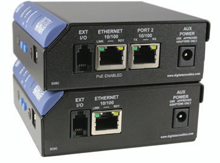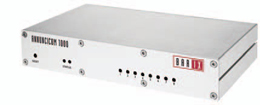In October 1998, Cisco announced that it was acquiring Selsius, a manufacturer of packet-based phone systems. That signaled the beginning of a new era in how we think about the use of our IP networks. Now, we routinely think of the transfer of voice, data, image, and video over these networks. It's no surprise that the intercom system is using the IP network.
Digital Acoustics' IP7 Ethernet/IP intercoms and IP intercom products provide voice-quality audio over local area (LAN) and wide area networks (WAN) with minimal bandwidth utilization and network support for PoE and dual RJ45 connections.
Why would a manager move intercom to the IP network? IP is densely distributed in most companies; every office is connected. Even utility closets and restrooms are within a few feet of the network. Intercom is audio transmission, including voice. So it's a natural extension to voice over IP (VoIP). Since the standards are written and the deployment of VoIP is well established, few changes need to be made to introduce intercom and paging. IoIP will be applied in much the same manner as traditional analog intercom. Schools, hospitals, companies, airports, and retail outlets will likely embrace its use. However, it will have applications in homes and churches, also.
Traditional intercom transmits audio signals from a central point to an outlet in analog form, usually over a pair of wires. The circuit is rarely shared with any other form of media. Paging systems use a similar method. However, intercom is point-to-point communications. A signal is sent in one direction and then a response is carried back. Paging sends a signal to many or all end-points and doesn't provide for a response. Both methods are possible over IP networks, however, paging places different bandwidth demands on the network because a common physical infrastructure is being used.
- THE IOIP ARCHITECTURE
- Like most client-server data applications, intercom systems have a star architecture. A central control system, often located in an administrative office or security office, sets up calls, defines end-point functionality, emanates broadcasts, and generally coordinates activities. When an intercom conversations starts, the voice signal is wrapped in an Ethernet/IP/UDP packet, the same as in VoIP. Even the codec that digitizes the signal is most often the G.711
Extron offers two types of hardware modules: the IPI 100 Series (shown), which require an IP intercom-enabled MLC 226 IP MediaLink Controller for operation, and the IPI 200 Series, which are standalone, IP-addressable modules.codec commonly used in VoIP systems. These packets are sent from one end to the other, often at the rate of 50 packets per second. When the voice conversation changes directions, the packets are sent in the opposite direction. A voice call in most IoIP systems currently uses about 80 kb/sec of bandwidth per direction per voice. This isn't much bandwidth on a LAN, but could become a significant issue on wide area network circuits.
The network used to support intercom can be the existing data LAN, assuming sufficient bandwidth is available and its characteristics are conducive to carrying voice and other real-time data, or you can build a separate network with inexpensive Ethernet switches. The most expensive part of a separate network is likely to be the dedicated cable runs, but, like conventional data networks, your intercom network could now use fiber in its backbone and cover very long distances between buildings. After the intercom signal is in IP packets, it can be carried over the internet. However, each of these new extensions of the intercom network brings with it significant concerns about performance and security.
WHO BUILDS IP INTERCOM?
Extron offers two approaches to IP intercom that fall within its MediaLink family. The 100 Series endpoints require an MLC 226 IP MediaLink controller. These would be used when the room needs AV control for a projector and a recording and play-out device. The 200 Series devices operate in standalone mode. On a one-button model, you can only push to talk. On a four-button model you can push to talk to four locations.
Extron Electronics also supplies a software control package called the IP Intercom Help Desk. You can use it and a PC with a headset to communicate to any room equipped with IP intercom. The Help Desk software allows you to configure the entire system from a single location. There is an auto-discovery feature that allows the easy addition of new stations. You can also create announcements as MP3 files and distribute them to individual rooms or groups of rooms.
Swiss manufacturer Barix AG builds a family of products to deliver audio over IP networks. It does IP intercom as a subset of that functionality. The key device is the Annuncicom 100. It acts as an interface between input devices such as buttons, microphones, and audio sources and out- put devices such as speakers. Of course, there is an interface to the IP network. It supports common audio formats such as MP3, G.711, and PCM for both voice and music. If a device develops a problem, it can send an SNMP alert to your network management software.
Software control on the Barix system is achieved through a browser. Each Annuncicom 100 has a built-in web server. So you'll be able to configure the system with any standard PC and a browser. The system also supports one-way audio back to the headend if you decide to record the

Digital Acoustics' IP7 Ethernet/IP intercoms and IP intercom products provide voice-quality audio over local area (LAN) and wide area networks (WAN) with minimal bandwidth utilization and network support for PoE and dual RJ45 connections. instructor's lecture. Besides G.711 and MP3, Barix recently announced support for the latest version of Advanced Audio Coding (AAC+) audio. If a security staff member needs to make an announcement in a crisis, they can go to any endpoint, authenticate with his or her Wiegand sensor card, and have control of the entire system. Barix also supports SIP calls and encrypted payload.
Digital Acoustics also has a primary network interface device, known as the IP7. Variations of the product allow the connection of a wall faceplate with a loudspeaker and supports an integrated two-port Ethernet switch. This allows you to cascade stations down a hallway or attach another IP device where the IP7 is located. The TalkMaster software comes in three versions. The LE version is designed for simple management of intercom calls, but supports WAV file playback for announcements. The enterprise EE version is designed for multiuser, multisite applications, and scales to thousands of endpoints. The third version, Talkmaster SMG, supports an interface to SIP phone networks so that an intercom call could go through the public phone network to a cell phone or other device.
TOA Electronics uses its NX-100 network audio technology to control the stations of its N-8000 Series IP network intercom system. TOA offers a variety of flush mount and telephone handset-type devices. It also features an executive override that allows for interrupting a call. Like the others, TOA's software package for management uses a browser interface. The N- 8000 scales to large deployments, however, you need one control unit for each 16 stations. Integrating other audio such as store music or ads is easy by using the auxiliary N-8000 MI multi-interface unit. It also allows connection to a PBX for calls though the public phone network.
NEW TECHNOLOGY: NEW ISSUES
Often when new technology is made available to the market, some important issues are not addressed. For example, IP intercom systems have some limitations. You'll need to be sure your security defenses are robust. Most of these systems have almost none of the standard protections such as encrypted payload or intrusion detection. The audio payload is carried in IP packets using communications technologies that are similar to the first VoIP systems. Like all IP network devices, they will be subject to denial of service attacks, snooping with packet sniffers, and may potentially be compromised and controlled. After all, they are small, dedicated computing systems with operating systems, TCP/IP protocol software, and other features that most clients and servers have. Some transfer the audio in WAV files. Free packet sniffers available on the web allow such audio transfers to be captured, stored, and possibly used to embarrass the school or company. Many sharp high school students would have the skills to
captured record the school counselor's conversation with a teacher. It could even get posted on YouTube.
Getting excellent audio output is not automatic either. Real-time audio transferred using IP is subject to interference from network broadcast traffic. (This isn't broadcast in the traditional AV sense. Here, we're referring to Ethernet and IP traffic sent to all devices using an address set to all binary ones.) Windows devices like to browse the network using such broadcast packets. Many management and control software systems use broadcasting as a simple means to send information to all of the devices associated with their applications. Even network management software often uses such discovery techniques. While broadcasts are used as a standard method of communicating in data networks, they can cause a disruption to IP-based audio that is expected to be delivered and processed in an even and efficient manner.
Some of the systems mentioned here support IP quality of service (QoS) methods. When this is used, the source station marks the packets with a code that is stored in the IP header. Each router in the network recognizes that mark and expedites the packet in deference to other packets that aren't marked. While QoS techniques are widely deployed, not all routers will be configured to read and process these marks. You'll need to work with the IT router technicians to make sure this happens.
The most significant feature to check out is how the devices are powered. If they include power over Ethernet support (PoE), the IoIP devices will get their power from the switch to which they are attached. If not, you'll need to pay a contractor to make sure there is a power receptacle near by, even if it's in the ceiling. The switches you purchase will need to support PoE also.
WHERE IS IP INTERCOM HEADED?
Customers will surely begin to ask for certain features that are standard in other IP devices. WiFi compatibility will be high on the list. Using wireless, the teacher could answer an intercom call from a handheld device. The doctor could ask the nursing station to page another doctor without finding a wall-mounted unit. IP multicasting will be a necessity on all of the systems. Currently, a few manufacturers such as Barix and Digital Acoustics support it, but others do not. When a broadcast is done without multicast capability, the amount of bandwidth needed is the amount needed by a single call multiplied by the number of stations the broadcast needs to reach. In other words, if one call takes 80 kb/sec, broadcasting to 20 stations takes 1.6 Mb/sec. That's too much. With multicasting, the bandwidth will be reduced to 80 kb/sec on each link in the path between the source and the output stations.
Another future enhancement is likely to be video. There are some situations in which adding videoconferencing would be just a convenient extra, but security concerns may make it a necessity for schools, hospital lobbies, and companies to screen all entrants. Nearly every manufacturer we talked to has this on the list of future enhancements.
Of course, if intercom moves to the desktop, calls and pages can be answered from there without moving even standing up. Since the PC is connected to the IP network, it's entirely feasible to do this.
